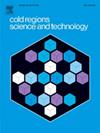Investigate the adhesion behavior and mechanisms of salty ice on bitumen surface based on the ice heterogeneous nucleation kinetics and quasi-liquid layer theory
IF 3.8
2区 工程技术
Q1 ENGINEERING, CIVIL
引用次数: 0
Abstract
Understanding the freezing and adhesion properties of de-icing salt solutions is crucial for optimizing de-icing strategies in infrastructure and minimizing damage to the environment and road materials from de-icing salts. This work employed a customized ice-adhesion testing system to investigate the evolution of ice-adhesion strength (IAS) of NaCl and NaCH₃COO salts on bitumen surfaces under different concentrations and temperatures. The icing phase transition process and thermodynamic properties of the salt solution were analyzed using multi-channel temperature setting and differential scanning calorimetry (DSC). Moreover, the adhesive mechanisms of salty ice were elucidated based on heterogeneous nucleation kinetics and quasi-liquid layer (QLL) theory. The results show that even a 0.5 wt% salt solution can lower the IAS to approximately 40–50 % of the value observed with pure water. The concentration of salt solution required to achieve adhesive failure is temperature-dependent. Additionally, the latent heat of fusion (hf) of NaCl solutions at concentrations from 0.5 to 2.5 wt% sequentially decreased by 45.3 J/g, 63.1 J/g, 79.9 J/g, 90.0 J/g, and 117.6 J/g compared to pure water. The freezing temperature (TF) of 2.5 wt% NaCH₃COO and NaCl solutions dropped by 1.3 °C and 1.6 °C, respectively. Based on the ice nucleation kinetics, lowering the TF and hf leads to an increase in the nucleation energy barrier (ΔG*), with IAS showing a logarithmic correlation with ΔG*. Furthermore, the QLL transitions from droplets to a thin film as salinity increases, further reducing the contact area and IAS. This work offers novel insights into the freezing progress and adhesion mechanisms of salty ice, aiming to reduce maintenance costs and environmental damage from de-icing salts.
求助全文
约1分钟内获得全文
求助全文
来源期刊

Cold Regions Science and Technology
工程技术-地球科学综合
CiteScore
7.40
自引率
12.20%
发文量
209
审稿时长
4.9 months
期刊介绍:
Cold Regions Science and Technology is an international journal dealing with the science and technical problems of cold environments in both the polar regions and more temperate locations. It includes fundamental aspects of cryospheric sciences which have applications for cold regions problems as well as engineering topics which relate to the cryosphere.
Emphasis is given to applied science with broad coverage of the physical and mechanical aspects of ice (including glaciers and sea ice), snow and snow avalanches, ice-water systems, ice-bonded soils and permafrost.
Relevant aspects of Earth science, materials science, offshore and river ice engineering are also of primary interest. These include icing of ships and structures as well as trafficability in cold environments. Technological advances for cold regions in research, development, and engineering practice are relevant to the journal. Theoretical papers must include a detailed discussion of the potential application of the theory to address cold regions problems. The journal serves a wide range of specialists, providing a medium for interdisciplinary communication and a convenient source of reference.
 求助内容:
求助内容: 应助结果提醒方式:
应助结果提醒方式:


